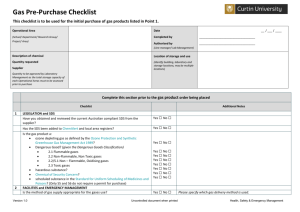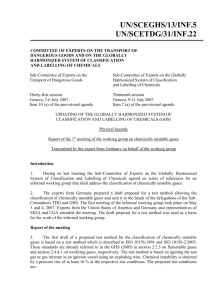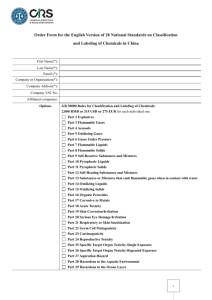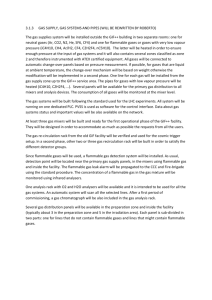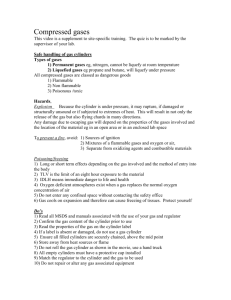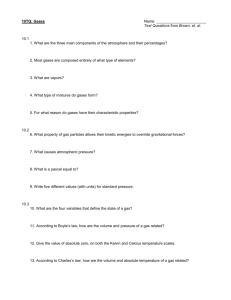harmonized system of classification
advertisement
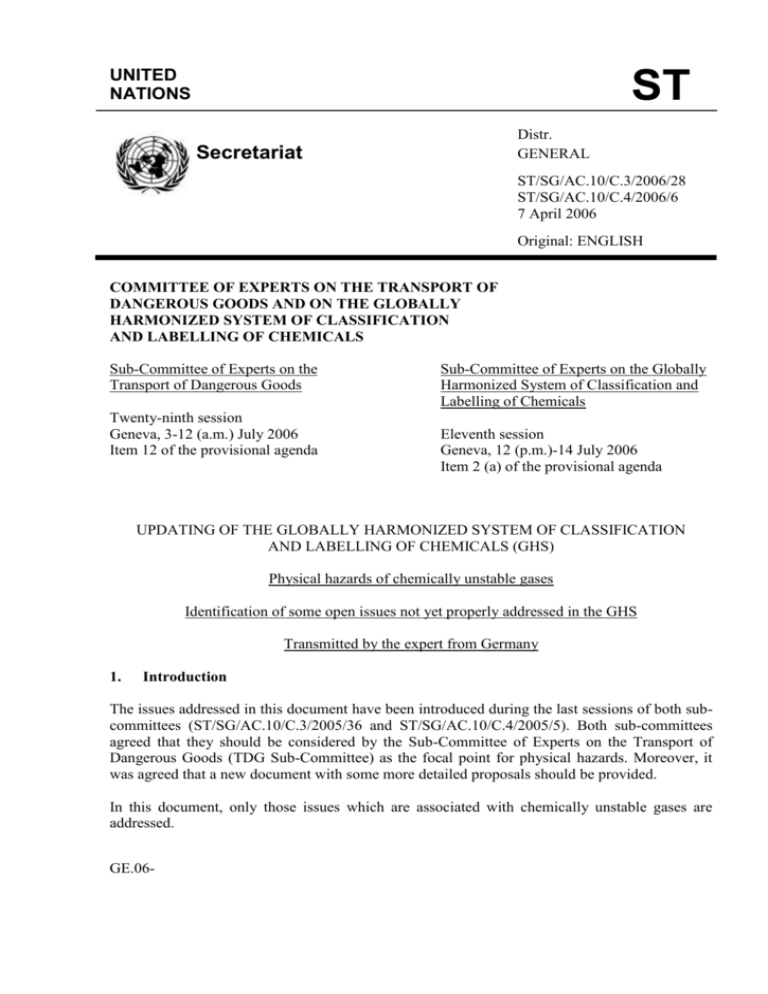
UNITED NATIONS Distr. GENERAL Secretariat ST ST E ST/SG/AC.10/C.3/2006/28 ST/SG/AC.10/C.4/2006/6 7 April 2006 Original: ENGLISH COMMITTEE OF EXPERTS ON THE TRANSPORT OF DANGEROUS GOODS AND ON THE GLOBALLY HARMONIZED SYSTEM OF CLASSIFICATION AND LABELLING OF CHEMICALS Sub-Committee of Experts on the Transport of Dangerous Goods Twenty-ninth session Geneva, 3-12 (a.m.) July 2006 Item 12 of the provisional agenda Sub-Committee of Experts on the Globally Harmonized System of Classification and Labelling of Chemicals Eleventh session Geneva, 12 (p.m.)-14 July 2006 Item 2 (a) of the provisional agenda UPDATING OF THE GLOBALLY HARMONIZED SYSTEM OF CLASSIFICATION AND LABELLING OF CHEMICALS (GHS) Physical hazards of chemically unstable gases Identification of some open issues not yet properly addressed in the GHS Transmitted by the expert from Germany 1. Introduction The issues addressed in this document have been introduced during the last sessions of both subcommittees (ST/SG/AC.10/C.3/2005/36 and ST/SG/AC.10/C.4/2005/5). Both sub-committees agreed that they should be considered by the Sub-Committee of Experts on the Transport of Dangerous Goods (TDG Sub-Committee) as the focal point for physical hazards. Moreover, it was agreed that a new document with some more detailed proposals should be provided. In this document, only those issues which are associated with chemically unstable gases are addressed. GE.06- ST/SG/AC.10/C.3/2006/28 ST/SG/AC.10/C.4/2006/6 page 2 2. Background Among the gases classified according to the GHS there are gases which are chemically unstable. At present chemical instability is understood as the ability to react dangerously without the presence of any other gas by decomposing or polymerizing. These gases are not classified as such but only based on other hazardous properties. They are classified together with stable gases e.g. as flammable, oxidizing or toxic. Examples are given in the table: Acetylene Nitrous oxide1 Decomposition Tetrafluoroethylene, stabilized Diborane Germane Polymerization and decomposition Ethylene oxide Classification for transport UN Model Regulations division 2.1, flammable gas (UN No. 1001, 3374) division 2.2, non-flammable, nontoxic gas subsidiary risk 5.1, oxidizing substance (UN No. 1070) division 2.1, flammable gas (UN No. 1081) division 2.3, toxic gas subsidiary risk 2.1 flammable gas (UN No. 1911) division 2.3, toxic gas subsidiary risk 2.1, flammable gas (UN No. 2192) division 2.3, toxic gas subsidiary risk 2.1, flammable gas (UN No. 1040) Hazard class according to GHS Flammable gas Oxidizing gas Flammable gas Flammable gas (in addition toxic) Flammable gas (in addition toxic) Flammable gas (in addition toxic, carcinogenic, mutagenic) Chemically unstable gases may be transported when the necessary steps have been taken. This subject is addressed in 4.2.2.4 of the UN Model Regulations on the Transport of Dangerous Goods: 4.2.2.4 Certain non-refrigerated liquefied gases are chemically unstable. They are accepted for transport only when the necessary steps have been taken to prevent their dangerous decomposition, transformation or polymerization during transport. To this end, care shall in particular be taken to ensure that portable tanks do not contain any non-refrigerated liquefied gases liable to promote these reactions. 1 Regarding chemical instability of nitrous oxide see for example: - "Code of Practice Nitrous Oxide" by EIGA, IGC Doc 116/04/E - D. Conrad, S. Dietlen, BAM Forschungsbericht 89 "Untersuchungen zur Zerfallsfähigkeit von Distickstoffoxid", 1983, ISBN 3-88314-263-8. ST/SG/AC.10/C.3/2006/28 ST/SG/AC.10/C.4/2006/6 page 3 2.1 Pure gases Transport The known pure gases which are chemically unstable are listed in the Dangerous Goods List (some examples are given in the above table). The "necessary steps to prevent their dangerous decomposition, transformation or polymerization" are taken care of by specific packing instructions which are associated with the entry in the Dangerous Goods List. Handling and use Chemical instability is not considered under the classification system of GHS. But since handling and use of chemically unstable gases require special precautions, operators should be informed about the chemical instability of gases they handle by an appropriate hazard communication. 2.2 Mixtures of gases Mixtures of gases which contain a chemically unstable gas might be chemically unstable themselves. Currently, neither in transport nor in use and handling, possible chemical instability of such mixtures is taken into account appropriately. 3. Proposals Chemical instability of a gas or a gas mixture requires special precautions during transport, handling and use. Therefore, appropriate hazard communication must be ensured. Currently, a method for the assignment of chemically unstable gases based on general criteria is not available. There is no test method for chemical instability in the UN Manual of Tests and Criteria, and even for pure gases, thermodynamic data (e.g. enthalpy of formation) alone do not provide enough information in order to decide whether a certain gas is chemically unstable. Therefore a new test method for the determination of chemical instability of gases and gas mixtures should be established. This test method should be easy to realize and should yield unambiguous results of sufficient accuracy. Development of such a test method should be considered for future work of the TDG Sub-Committee in cooperation with the GHS SubCommittee. The concrete technical work may be carried out by the working group on gases of the TDG Sub-Committee. The new test method could be based on the methods described in ISO 10156:1996 which is referred to in the UN Recommendations on the Transport of Dangerous Goods and in the GHS for determining the flammability of gases and in ISO 10156-2:2005 which is referred to in working documents ST/SG/AC.10/C.3/2006/2 and ST/SG/AC.10/C.4/2006/2. The test apparatus and the criterion for a positive test result could be selected as described in ISO 10156-2. Testing conditions as far as pressure and temperature are concerned would have to be agreed. They could ST/SG/AC.10/C.3/2006/28 ST/SG/AC.10/C.4/2006/6 page 4 be selected following the conditions during transport since handling and use most often will not occur at higher pressures. As long as such general criteria and a general test method are not available, it might be considered that for those gases which are known to be chemically unstable the GHS refers to the respective specific entries in the TDG list thus allowing for adequate hazard communication. Mixtures containing chemically unstable gases should be addressed as well. One solution might be to consider mixtures of gases which contain a chemically unstable gas as unstable, unless proved otherwise. ______________

